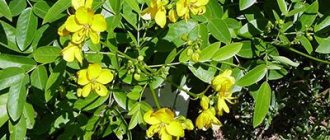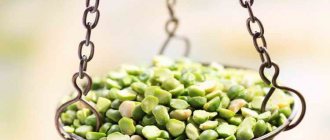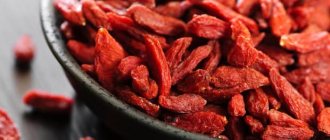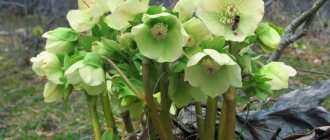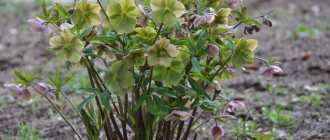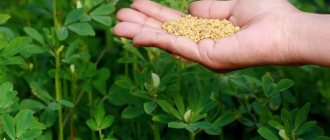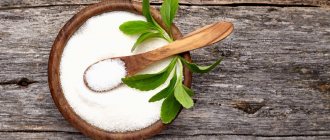To lose weight faster, the body needs to be cleansed of excess. This is exactly where Super Slim helps - a very tasty tea for slimming. Find out how to take it correctly to lose kg without harm to your health!
- Customer Reviews
Author: Kristina Lobanovskaya, doctor, practicing nutritionist Article updated: 04/07/2021
The modern market for weight loss products offers many options for quickly and effectively losing extra pounds without much effort. All that remains is to choose the right drug that will not only help solve the problem, but will also do it without harm to health. The most controversial in this regard are considered to be various cleansing herbal teas, which in reasonable quantities can indeed provide weight loss, but if the dosage or duration of use is exceeded, they can become dangerous to the body. Judging by consumer reviews, this is exactly what “Super Slim” is – a weight loss tea from the Russian company Fitera. The product is very accessible because it is sold in all pharmacies and has a low price. Despite the fact that the manufacturer positions it as a means for weight loss, this product is most popular among people with intestinal atony to activate intestinal peristalsis and increase tone. This is due to the fact that “Super Slim” herbal tea provides a mild laxative effect, has a pleasant taste with a variety of aromas and costs much less than the cheapest laxative tablets.
Composition and beneficial properties of Super Slim
The tea contains herbal ingredients such as:
- Sudanese mallow;
- alexandria leaf (senna);
- rosehip berries;
- Melissa.
In addition to the unflavored drink, teas with natural flavors are available. You can buy tea with the following flavors:
- raspberries;
- strawberries;
- strawberries;
- tropical fruits;
- lemon;
- mint;
- peach;
- black currant.
Tea has many beneficial properties due to the components of the drink.
Sudanese mallow (stockrose) flowers contain a large amount of vitamins that help increase the body's defenses. In addition, the herbal product has a strong diuretic and choleretic effect, which has a beneficial effect on the gastrointestinal tract. Polysaccharides and pectin contained in flowers remove harmful substances from the intestines. Thanks to this cleansing effect, mallow promotes weight loss.
Alexandria leaf has a strong laxative effect due to the anthraglycosides contained in the plant, which irritate the receptors of the mucous membrane of the digestive tract, reducing the secretion of secretory fluid and increasing the number of contractions of the walls of the large intestine. In addition, senna helps remove excess fluid from the body, as a result of which puffiness goes away and cellulite decreases.
Rose hips improve the functioning of the digestive tract and physical performance, stimulate collagen production, normalize water-salt balance and accelerate metabolic processes. In addition, rosehip has a diuretic, choleretic, tonic and anti-inflammatory effect.
With tea you can speed up your metabolism and strengthen your immune system. Despite the beneficial properties of tea, you should consult a doctor before drinking.
Useful properties of Super Slim
Mallow beneficial and medicinal properties for the body
When visiting Japan in May, you can take part in a festival dedicated to mallow. Residents of the country consider the flower to be their patron, preventing natural disasters. The plant is also popular in other countries. In Europe, mallow is considered a bride's assistant, in Ancient Rome it was used as a universal antidote, and in Arab countries mallow soup is in great demand.
This plant is called rose stock, mallow, kalachik, “Cinderella at the fence.” The mallow received its last name because it often grows along hedges or near the road and does not require special care.
The grass is common in temperate latitudes of Asia, North America, Europe and Africa. More than 20 plant species have been discovered. The most common annual plant is wood mallow. In Europe there are also perennials - hybrid, rugose and biennials - Sudanese, whorled. Depending on the species, mallow can have a straight, ascending or creeping stem with a length of 30 to 200 cm. The leaves of the plant are heart-shaped and rounded with carved edges, and the flowers are varied in color - white, pink, red, lilac.
In addition to magic and cooking, mallow has long been used in folk medicine. Healers use its petals, seeds and roots to eliminate health problems, and modern scientists are studying the effect of the plant on the human body and the possibility of use in official medicine. The article presents the conclusions of experts about the benefits of mallow, the rules for its use, and recipes for preparing medicinal products.
Useful properties, research
Traditional healers noted that mallow can be used to make medicines for internal and external use. Modern research proves that such use of the plant is justified. Often, studying one mechanism of mallow’s effect on the body leads to confirmation of other beneficial properties. An example is the work of a group of specialists from Canada, Brazil and Chile, the results of which were published in 2021.
Researchers studied the antioxidant effect of the plant. They confirmed the ability of mallow extract to reduce the rate of cell aging. However, its anti-inflammatory effect has also been demonstrated after internal and external use. In their conclusions, scientists recommended using mallow to create drugs for chronic pathologies.
When describing the beneficial qualities of mallow, they indicate:
- Elimination of diarrhea.
- Healing of wounds, burns of the skin.
- Relief from cough.
- Slowing down the aging process.
- Stimulating the removal of fluid from the body.
- The ability to coat mucous membranes.
- Reduced swelling.
- Relieving inflammation.
- Detoxification.
- Accelerating the weight loss process.
- Increasing the body's ability to resist infections.
Contraindications and possible harm
When studying the benefits of mallow for the human body, experts do not find conditions in which the plant is harmful. However, this only applies to herbs collected in ecologically clean regions. The only contraindication to taking medications is individual intolerance.
Is it possible for children
Mallow can be used to treat children. It allows you to relieve your child of cold symptoms, eliminate skin rashes, and improve health without the use of synthetic products. However, it is worth considering that mallow is classified as a medicinal plant, so when treating children, you must adhere to several rules:
- Do not start therapy without first consulting a pediatrician.
- During the appointment, monitor changes in the child’s condition.
- If a negative reaction occurs, stop taking the medicine and consult a doctor.
Pregnant and lactating
During the first few months of bearing a child, experts recommend refraining from taking medicinal herbs. However, from the 2nd trimester, pregnant women can use mallow to eliminate external defects and take it in the form of tincture or tea. Mallow is also allowed to be treated during breastfeeding. It does not affect the quality of lactation and does not change the taste of milk.
Pregnant and lactating women are recommended to use mallow when they have problems with the intestines, to get rid of edema, relieve inflammation of the genitourinary system, and eliminate cough. However, before starting use, it is necessary to discuss with your doctor the safe dosage, duration, and regimen.
Recommendations from nutritionists for losing weight
Mallow is one of the components included in herbal preparations for weight loss. It allows you to eliminate the main factor leading to excess weight – disruption of the digestive system. Nutritionists believe that using mallow can speed up weight loss and reduce the risk of exhaustion when limiting your diet. For rapid weight loss, use teas and infusions of flowers and leaves for 30 days.
Some people are confused by the calorie content of the dry product - 250 kcal per 100 grams. However, experts remind that to prepare infusions you need no more than 10 grams of mallow, so the energy value of the product is no more than 25 kcal per day.
Chemical composition of forest mallow
The medicinal properties of forest mallow are due to its rich chemical composition. All parts of the plant contain:
- fructose;
- sucrose;
- glucose;
- vitamins B1, B4, C, A, E, PP;
- essential oils;
- tannins;
- carotenes;
- flavonoids;
- calcium;
- iron;
- phosphorus;
- amino acids;
- enveloping mucus.
Features of drinking tea
According to the instructions, to prepare herbal tea, which contains Sudanese mallow, lemon balm, rose hips and Alexandria leaf for weight loss, you need to fill 1 filter bag with 200 ml of hot water, and then leave the drink for 20 minutes to brew. The product should be consumed during meals in the first half of the day, ½ glass 2 times a day. Duration of treatment is 14-21 days. A repeated course can be carried out only after 30-60 days.
It is contraindicated to drink this herbal tea if:
- pregnancy;
- lactation;
- intolerance to any tea components;
- acute gastrointestinal diseases;
- heart failure;
- pathologies of the liver and kidneys.
How to take tea for weight loss
The medicinal properties of mallow and contraindications will exceed all your expectations
Dry cough is one of the most unpleasant and intractable symptoms of bronchitis and tracheitis. Even in ancient Egypt, the medicinal properties of mallow and its contraindications were known. Doctors prepared unique expectorant medicines from rosewood. In addition, they used its infusions to treat patients suffering from various diseases of the genitourinary system and gastrointestinal tract. These corrugated flowers were also added to tea, and some women prepared special infusions from them for weight loss. Not much has changed since those times, as mallow still benefits millions.
The seeds of the culture are brewed with coffee/tea or added as a seasoning to meat/fish dishes. During heat treatment, essential oils are released into the liquid, which clear the human respiratory tract of mucus.
Medicinal properties of mallow and contraindications: a brief overview
When inflammatory processes progress in human organs, they increase in volume and swell. All this leads to painful sensations. Sudanese mallow contains a valuable viscous substance that envelops all nerve endings. The sticky suspension protects tissue fibers from irritants and relieves inflammation.
Despite the fact that the chemical composition of the culture has not been fully studied, the following were found in it:
- vitamins A and C;
- carotene;
- up to 18% essential oils (applies to seeds);
- phytoestrogens;
- iron, cadmium and zinc.
The harvesting of useful raw materials is planned for the flowering season. The buds of the plant are picked together with the calyxes, but the leaves and stems are picked separately. The roots are dug up in late autumn - October, November. Dry the raw materials under a canopy, periodically turning the petals over. The flower collection is stored for 2 years, and the leaves for 1 year.
There are practically no contraindications to the crop, except for individual intolerance to individual components of the plant. Therefore, it is quite acceptable to use mallow during pregnancy. However, it is better to consult a doctor on this issue.
Effective compresses are made from infusions of the culture, which help relieve puffiness of the eyes. In addition, such procedures are carried out in the treatment of all kinds of ulcers, as well as extensive wounds. The amazing properties of Sudanese mallow flowers help restore the mucous membrane. For this reason, hollyhock is included in complex therapy for severe diseases of the throat and oral cavity. Decoctions and infusions with the addition of dried flowers are used as medicine.
The use of mallow: the subtleties of ancient therapy
Ancient healers used the root of the plant as the basis for preparing medicines. Today, healing decoctions are prepared with it, which serve as impregnation for lotions. Among other things, they are an excellent diuretic, discovered by Tibetan monks. At the same time, an extract is made from the flowers and leaves to obtain a medicinal mallow extract.
It is included in many cosmetic products because:
- participates in cell maturation;
- helps accelerate collagen synthesis, as well as metabolism in cells;
- relieves inflammatory processes on the skin;
- removes swelling.
It is noteworthy that fresh leaves are applied to wounds or inflamed areas of the skin. The juice released during this process disinfects the cut and promotes its rapid healing. When treating a cold or bronchitis, you will need a special infusion.
To prepare it you need:
- 20 g dried leaves;
- pour 200 ml of boiling water;
- leave for 2 hours.
After the mixture becomes saturated, it is filtered through several layers of gauze. Take this drug ½ glass 2 times a day.
An infusion is prepared as an emollient and anti-inflammatory agent from:
Take 200 g of the main ingredient, and 1.5 times less of all the others. Pour the mixture of herbs into a liter of water and leave for 24 hours, and then filter. The resulting elixir is poured into a bath, which is taken before bed. Such spa treatments are recommended for serious problems with the spleen. In this way, you can make maximum use of all the medicinal properties of mallow and (the only contraindications to it are allergies) get an excellent result.
Like all homeopathic medicines, infusions and decoctions are recommended to be taken in the first stages of the disease. Otherwise, it will be necessary to extend the course of treatment to several weeks, and this may cause unwanted side effects.
Uses of Sudanese mallow: a valuable archive of recipes
Rose stock is used in the treatment of various diseases. For each of them there is a separate recipe for preparing a healing potion.
Here are some of the recommendations from the archives of traditional medicine:
- Pancreatitis. Mallow juice (1 tsp) is squeezed from leaves and flowers during budding. Mix with honey and add warm water (250 ml). The resulting mixture is distributed so that it is enough for 4 doses per day.
- Colitis and constipation. For 1 liter of boiling water you will need 1 tbsp. l. The mixture is infused for 10 minutes and then filtered. The resulting infusion is drunk throughout the day, that is, in 4 doses.
- Obesity. The unique properties of Sudanese mallow flowers are used for weight loss. The dried flowers and leaves of the plant are crushed together with the inflorescences of the plant. You will need 10 g of each ingredient. The mixture of herbs is poured with water (250 ml) and boiled for 20 minutes. Cool at room temperature and filter. Take for a month.
- Stomatitis and skin wounds. A collection of herbs (30 g) is steamed in 1 liter of boiling water, left for 10 minutes and filtered. The resulting elixir is used to rinse the mouth several times a day or make a lotion on cuts.
In addition, mallow petals are added to tea, which improves digestion. It is often used to normalize stool in cases of severe intestinal upset (diarrhea). The components contained in the plant help to liquefy phlegm, so it is drunk when you have a severe dry cough.
You can also prepare a stronger drink yourself, which is infused for up to 10 hours and stirred periodically. For 250 ml of boiling water you will need 2 tsp. dried leaves. To enhance the expectorant effect, experts recommend adding honey.
Mallow in cosmetology - the genius of pure beauty
In addition to the anti-inflammatory effect, infusions of hollyhock have other effects. The plant produces valuable melanin. Wipe your face with its decoction several times a day. As a result, the skin acquires an original copper shade.
Extracts from mallow can often be found in:
Such cosmetics have a softening effect on dry skin. Cosmetic ointments based on mallow extract are used to lubricate rough heels with cracks, as well as acne, burns, boils and areas of skin affected by eczema.
This extract is part of preparations that are used to straighten hair. The product is applied to curls and not washed off. But balms, masks and conditioners are used to combat brittle and split ends.
Taking into account all the medicinal properties of mallow and contraindications, it can be noted that it serves as an excellent expectorant and anti-inflammatory agent. The flowers, leaves, seeds and roots of the plant are used for medicinal purposes. They are added to tea, coffee and other dishes. With the help of this “natural helper” you can cure dry cough, inflammation and wounds on the skin, and also lose several kilograms.
How to prepare Sudanese mallow and Alexandrian leaf?
To preserve the beneficial properties of medicinal plants, they must be properly harvested. When harvesting mallow, you must adhere to the following rules:
- Stockrose flowers should be collected during the flowering period along with the calyx or just the petals;
- the most useful are dark-colored flowers;
- Drying flowers is required in the shade in a well-ventilated area; laying them out in the sun is strictly prohibited;
- Dried parts of mallow should be stored in paper bags for up to 2 years.
Senna leaves are collected only when they are fully developed. They need to be plucked from the stem and dried in ventilated areas or special dryers. You can even harvest wild species of Alexandria leaf.
Senna fruits must be harvested after they are fully ripe. During 1 season, leaves are collected up to 3 times. The first collection is carried out in August, then - after 1-1.5 months and the last time - before the onset of frost (if the leaves have time to grow). Alexandria leaf, whose properties remain unchanged for 2 years, is recommended to be stored no longer than this period.
How to prepare Sudanese mallow
A beautiful and useful mallow plant came to us from Asia Minor, the properties of which are successfully used in folk medicine to this day. You can find annual varieties if you need to create a new composition in your flower bed or flower garden every year. You can plant biennial plants like Sudanese mallow and wood mallow. Or you can look for a perennial. These peculiar flowers have a wide variety of colors, except blue and light blue. Therefore, they look great in any place in the garden: in flower beds, in secluded corners near benches, in flower beds.
All hollyhocks are drought-resistant and love sunny, bright places and abundant watering. In folk medicine, the pulp from the leaves of this plant is used as an antiseptic for wounds. Gargling with decoctions helps with colds.
Research, medicinal properties after freezing
In addition to drying, another long-term storage method for mallow is often used - freezing. This method has the advantage of being able to obtain plant juice. After defrosting, the foliage releases moisture no less actively than fresh raw materials. Scientists also found that mallow does not lose its beneficial properties after cold processing. Proof of this is the experiments of specialists from the Egyptian Research Institute, conducted in the 90s of the last century.
When comparing the concentration of vitamins and microelements in frozen mallow and spinach, it was found that the former retains a set of beneficial qualities longer. During 3 months of being kept at a temperature of -18 degrees, spinach lost a lot of moisture, ash, and oxalic acid, and changes in the chemical composition of mallow were insignificant. However, scientists noted that it is impossible to defrost the product using rapid heating, since it actively loses its medicinal qualities.
Perennial mallows
We plant this type of plant in the soil with seeds in mid-May - early June. They usually do not germinate together. The germination period lasts from 10 to 14 days. You can plant the seeds immediately in a permanent place, or you can grow them in a kind of nursery for further transplantation to a certain plot of land. Perennial mallows are also planted in seedlings. But planting in the ground should be done only in early August, because the plant produces a rosette of leaves in the first year, and shoots out a stem with buds only the next year. The distance between plants should be 50-70 cm, and for the winter it should be covered or mulched with peat. Perennial mallow blooms only in July and continues flowering until early October, gradually opening more and more buds.
This plant is biennial and needs to be grown in seedlings. It is advisable to treat the seeds with potassium permanganate. I don't always adhere to this wish, but the flowers grow tall and large. When the seedlings grow up, I plant them in disposable or peat cups so as not to damage the roots when planting. And only then in September I plant it in the place of future flowering. Usually, in all garden plots, corners enclosed by a fence look very uninviting. And if your fence is made of mesh or simply does not have much shade, then Sudanese mallow will turn these places into wonderful bright corners that will always attract the attention of your guests and delight you.
Malva woodland
This plant is often planted as an annual, although in fact wood mallow is also a biennial plant.
Its stems, unlike other types of mallow, need to be supported or tied to a tripod. When flowering ends, the stem needs to be cut. Mallow flowers are very bright and attract insects that feed on nectar. The mallow flower is a wonderful honey plant and bees love to collect pollen and nectar from it. We always plant this plant not far from the hives and plant vegetable crops nearby so that the bees attracted by the bright flowers pollinate them too. Look what beautiful and delicate inflorescences the forest mallow has; the photo clearly demonstrates its exquisite forms! I really like mallow, which is easy to grow. Sudanese mallow - properties, applications
Sudanese mallow or hollyhock is grown as a perennial plant, and in most cases it is grown simply for beauty. But Sudanese mallow has many beneficial properties.
Sudanese mallow can grow up to 2 meters in height; it decorates gardens with its flowering from July until autumn. Mallow flowers are large, collected in a spike, and look very decorative.
What medicinal properties does Sudanese mallow have?
Sudanese mallow contains tannins, bitterness, mineral components, starch, phytosterol, and plant mucus.
Thanks to this composition, mallow has an expectorant effect. But it is rarely used as a separate remedy. Most often, mallow is combined with other plants, and in complex therapy it has a fairly good effect, helping to cope even with bronchitis.
Infusions and decoctions are made from rose stock, which have an anti-inflammatory as well as astringent effect. These infusions treat stomach diseases and intestinal disorders.
A useful infusion is prepared from mallow flowers to treat diarrhea and kidney disease. It also helps with problems with the throat and oral cavity.
Another healing property of mallow is its diuretic. Therefore, those who want to lose a couple of kilograms and remove excess water from the body drink an infusion of mallow.
Chemical composition of forest mallow
The medicinal properties of forest mallow are due to its rich chemical composition. All parts of the plant contain:
- fructose;
- sucrose;
- glucose;
- vitamins B1, B4, C, A, E, PP;
- essential oils;
- tannins;
- carotenes;
- flavonoids;
- calcium;
- iron;
- phosphorus;
- amino acids;
- enveloping mucus.
However, the concentration of useful substances in the above-ground part of the plant, roots and extract differs. Features of the composition of the mallow:
- Seeds. Rich in fatty oils – up to 18%.
- Root. Contains bitterness, mineral salts, starch, zinc, cadmium, phytosterol, anthocyanins.
- Leaves. Saturated with vitamins A, C, B, calcium, iron, phosphorus, amino acids.
- Mallow extract. It is obtained by soaking flowers and leaves, so it contains concentrated substances that the above-ground part of the plant is rich in: vitamins A and C, polysaccharides, amino acids.
Features of harvesting Sudanese mallow
In order for infusions prepared from mallow to be beneficial, it is very important to correctly collect the raw materials and prepare them. To do this, you need to remember only three rules:
- Sudanese mallow flowers are collected during the flowering period along with the calyx, or exclusively the petals themselves.
- The darkest-colored flowers are considered the most useful.
- You need to dry the collected flowers in the shade, in the open air. Store in a breathable paper bag in a dark place.
Infusions from Sudanese mallow are prepared in the same way as from wild mallow, which we wrote about a little earlier. When using prepared infusions, remember that, despite the absence of contraindications and little knowledge of the properties of this plant, you still need to handle it carefully.
Alexandria leaf is a plant that can be classified as a member of the legume family. It has the appearance of a subshrub with a fairly straight stem. This plant has bright yellow flowers. The fruits look like flat beans, in the middle of which grow from 6 to 8 small seeds. The period when the plant begins to bloom lasts from June and ends in September. The fruits begin to ripen in October. Alexandria leaf is a low plant, its maximum height is no more than a meter. It can have a positive effect on the human body. The leaves of the subshrub have more beneficial properties.
Hibiscus tea, mallow or Sudanese rose flowers
The price is for 50 g
Once you try hibiscus tea, you will become a fan!
For Egyptians, ruby hibiscus tea is one of the symbols of folk culture. The inhabitants of Egypt called it the elixir of the ancient pharaohs.
Hibiscus tea is obtained from the flowers of the Sudanese rose of the Hibiscus genus. Sudanese rose is cultivated in countries such as India, China, Thailand and Mexico. The inflorescences are harvested when they reach the peak of their flowering, become fleshy and acquire a bright burgundy color. The finished drink has a spicy aroma and a pleasant sweetish-sour taste.
Hibiscus, whose benefits have been proven for a long time, has not without reason conquered almost the whole world. The drink with its pleasant sour taste and unique aroma will refresh you on a hot day and warm you in winter frosts. Tea improves health, improves the immune system, stabilizes blood pressure and serves as a natural antibiotic. Its beneficial effect on the human body is limitless!
Try real hibiscus tea. Surely it will become your favorite drink!
How is hibiscus useful ? The beneficial properties of hibiscus tea are truly multifaceted!
The bright buds of hibiscus have extraordinary healing properties. Hibiscus tea, prepared from the petals of the Sudanese rose, contains a large amount of vitamins and minerals.
Microelements valuable for the body, such as potassium, phosphorus, sodium and iron, enriched hibiscus tea with beneficial properties.
You can buy this divine drink from the best manufacturer on our website at the best price.
Hibiscus, the benefits of which are invaluable, is ideal for strengthening the human immune system. Its properties are determined by its composition. The drink helps protect the body from various infections. Hibiscus, whose properties allow it to relieve spasms and reduce body temperature, is often used to prevent or treat various colds and viral diseases.
There is an opinion that hibiscus tea increases blood pressure. But its effect is ambiguous. Depending on the form in which the drink is consumed, it will increase or decrease blood pressure. Hot hibiscus increases blood pressure, doctors recommend it for people with hypotension. And cold hibiscus lowers blood pressure, so it will be useful for hypertensive patients.
Hibiscus tea gently corrects the menstrual cycle in women. With regular use, it can fight depression and neuroses. The drink has a gentle effect on the gastrointestinal tract.
The high content of vitamin C makes tea an excellent aid for ARVI. If you are trying to lower your blood sugar or cholesterol, Egyptian red hibiscus petal tea should be part of your daily diet.
It is considered a good folk preventative against cancer.
Hibiscus tea for weight loss.
What are the benefits of hibiscus tea for weight loss? Organic acids found in Sudanese rose have a positive effect on metabolism and promote rapid fat burning.
Tea is also a mild laxative, which helps remove toxins from the body.
To lose weight, this drink must be consumed for one month, then take a short break and repeat the course again.
Hibiscus tea children and pregnancy
Can children have hibiscus tea? Due to its mild and delicate effect on the body, hibiscus tea is recommended for children over one year of age. Younger children are not recommended to drink hibiscus tea due to the risk of developing allergies.
How to drink hibiscus tea during pregnancy? The only restriction during pregnancy is the rate of tea consumption. Do not overuse hibiscus tea during pregnancy. But one cup of drink a day will benefit both the baby and the mother.
Properties
Most often, bush leaves are used to make raw materials. But there are many recipes where you need to use only fruits. Alexandria leaf has quite varied properties. It has a positive effect on the functioning of the large intestine. This remedy is a fairly good laxative and also a choleretic agent.
Helps with diseases such as:
- haemorrhoids;
- acute conjunctivitis;
- various skin diseases;
- gallbladder diseases;
- for liver problems.
Application, subtleties of ancient therapy
Mallow has long been used in various areas of human life: magic, cooking, medicine, gardening. The popularity of a plant can be judged by the frequency of use of its name. For example, mallow gave its name to a sewing machine and a series of cosmetics. There is even a shade of green with this designation.
The mallow flower is popular among modern landscape designers. As you can see in the photo, it is planted along hedges and in flower beds near houses. Garden and wild plants are used to create food dyes, and Asians use the leaves of the grass to prepare salads and first courses. Mallow extract is used in the production of baby creams and cosmetics with anti-aging and regenerating properties.
However, it is the medicinal effects of mallow that are most famous. To this day, the recommendations of ancient healers are applied:
- for lotions, infuse the herb for at least 2 hours;
- squeeze out the mallow juice during flowering;
- To prevent baldness, we prepare products from mallow juice and vegetable oils;
- We drink mallow tea warm, in small sips;
- to eliminate boils, apply fresh mashed leaves to the inflamed area;
- for problems with potency in men, we use only wild mallow in the form of infusions or tea;
- when treating ulcers we use crushed seeds;
- to enhance the expectorant effect, prepare the infusion for 10 hours;
- When creating infusions, add water brought to a boil to the herb and boil the plant for at least 20 minutes.
Recipes for common diseases
During therapy we use recipes known for several centuries:
- Pancreatitis. We collect mallow juice and dilute it with boiled water in a ratio of 1 teaspoon of raw material per 200 ml of liquid. Cool to room temperature before use.
- Inflammation of the spleen. Mix mallow with chamomile, green oats and Chernobyl in equal parts. Fill with water at the rate of 450 grams of mixture per 5 liters of water. Place on the stove and simmer over low heat for 20 minutes. Strain and pour into a filled bath. We take water procedures 2 – 3 times a week for 15 minutes.
- Bronchitis and other conditions accompanied by an unproductive and debilitating cough. Take 2 teaspoons of dried mallow leaves or roots. Pour 250 ml of boiling water and leave for 10 hours. Strain, drink 1-2 tbsp. spoons 3 – 4 times a day. You can also gargle with this infusion.
Methods of use
The above tool can be used in the following variations:
- decoction;
- infusions;
- pills;
- powders.
In the fight against excess body weight, as well as against toxins and fecal deposits, the Alexandrian leaf helps tremendously. Tea made from it is best suited to achieve these goals. It contains a large number of different active substances that give the drink laxative and antiseptic properties.
You need to know that consuming Alexandria leaf will not harm the human body. The process of losing body weight occurs due to the fact that intestinal function is stabilized.
Treatment
You can collect it yourself. Leaves are collected twice a season, but it is better to do this in August. At this time they are already starting to turn a little yellow. The fruits, as well as the leaves, contain a very large amount of organic acids and other useful substances. It is thanks to them that various ailments in the large intestine are treated.
The prepared tinctures help with pain in the joints. If you take fresh leaves of the Alexandria leaf and just one liter of Cahors, you can prepare a very healing infusion. This remedy will perfectly help cope with chronic constipation.
Alexandria leaf for weight loss has very good reviews, especially in cases where diets do not show the desired result, as well as if symptomatic constipation occurs. You just need to know the correct recipe for preparing a decoction or tincture. It is necessary to take the drug at regular intervals, usually 2 times a day. The dosage should be approximately half a glass.
Cleansing the body
Alexandria leaf is recommended for use for weight loss. It is able to cleanse the intestines as much as possible, which will help normalize its functioning, improve motility and, in turn, significantly reduce the process of fat absorption. A positive result will be noticeable after about 2-3 days, but changes will be felt within 6-8 hours from the moment of using the product.
There is another name for the Alexandrian leaf - it is senna. This drug has a very gentle effect on the body. If we compare it with various other medications, then Alexandria leaf for weight loss has positive reviews in most cases, since it quite gently restores and shapes stool.
What is hydrolate for face, body and hair?
This product is obtained by steam distillation.
How it all happens: plant material is placed over boiling water and hot steam is passed through it, which is thus saturated with substances useful for our appearance. Next, the steam is cooled and divided into fractions - essential oil and liquid. The latter is a hydrosol, also called hydrosol and floral (floral) water. You can make hydrolate at home, but for this you will need special equipment - a distillation cube or alambic. And don’t forget that making it yourself requires time, effort and appropriate skills. It’s easier to buy a ready-made product, especially since stores offer a variety of options, including those for which it is quite difficult for a non-professional to find the source material.
Natural lavender hydrolate 100%, 100 ml, Levrana
500 ₽
Dietary supplement NOT A MEDICINE
Cooking yourself at home
To prepare a healing infusion at home, you need to take one tablespoon of the plant, grind it very well, and then place the whole product in a bowl where one glass of boiling water has already been poured (the water must be boiled). This infusion should be left alone for about eight hours. After the specified time has passed, you need to strain the mixture through a fine sieve or cheesecloth.
There is another way. You need to take ¼ liter of boiling water and pour in about two tablespoons of raw material, then you need to heat this broth for about half an hour, but not in direct contact with gas, but through a water bath. Next, the prepared mixture must be cooled for approximately 35 to 45 minutes, then filtered well and squeezed out the raw materials. The amount of prepared infusion must be brought to the initial amount. The method of use is quite simple. You need to drink 0.5 glasses twice a day - morning and evening.
In order to treat diseases such as atherosclerosis, you need to prepare 15 grams of rose hips, several birch leaves, mint, carrots, burdock root and, of course, Alexandria leaf. All of the above ingredients must be crushed, then mixed and poured with one liter of boiling water. Leave the mixture for 1 hour. After time, it is necessary to consume half a glass of the decoction three times a day, preferably after meals.
In order to cure colitis, you need to prepare in advance in equal quantities Alexandria leaf, fennel fruits, caraway seeds, mint, St. John's wort, plantain leaves, chamomile flowers, immortelle flowers. After all the components have been collected, you need to mix them well, and then pour two tablespoons of the mixture into 0.5 liters of boiling water. Let the broth brew for about 35 minutes, then strain through a fine sieve or cheesecloth, which is folded several times. You need to consume 100 grams of the prepared decoction before meals.
Features of use
It is also recommended to alternate the Alexandrine leaf with any other means for losing body weight, so that there is no addiction. Moreover, it is necessary to remember that there must be moderation in everything, since if the dose is significantly increased, then many unpleasant consequences are likely to occur. A person may begin to develop intestinal dystrophy, or the lining of the stomach will be severely irritated.
Before you start using the above product, no matter in what form, you must first consult with a qualified specialist in order to avoid unpleasant consequences.
When choosing plants for a flower garden, mallow is not the first thing people think of. However, novice gardeners come to the same conclusion as experienced professionals: without mallow you won’t have a beautiful and spectacular flower garden! Therefore, mallow is a perennial plant with a centuries-old history, and is still loved by many today. It looks good in the landscape of a small summer cottage, and near elite cottages. Mallow is summer and sun, brightness and beauty, calm and serenity. Let's take a closer look at this amazing flower; mallow deserves our attention.
Let's start our acquaintance with a botanical description that provides basic information about the plant.
mallow flower
Mallow is a herbaceous plant, a member of the Malvaceae family. An erect, tall plant can reach a height of 80 to 250 cm.
Growing on a stem, foxtails have a rounded shape, the edges of the leaves are notched. The size of the leaves varies depending on the location. In the lower part of the plant they are larger; the higher on the stem they are located, the smaller their size.
The funnel-shaped flowers are collected in inflorescences and decorate the upper part of the plant, starting at a height of 100 cm and above. The flowers are large, with a diameter of 6 to 12 cm, and can be simple, semi-double, or double. The colors of the flowers are varied: white, shades of yellow, pink, red. After flowering ends, fruits appear on the plant - many segments formed into a dense ring. When ripe, the fruit ring is divided into these independent segments.
The flowering of perennial mallow lasts almost the entire summer, from June to September.
Sudanese mallow for weight loss. Powerful Calorie Blocker
Weight loss tea Flying Swallow - composition, instructions for use, results and reviews Price for Lose Weight tea Low prices for Lose Weight tea allow everyone to try the effects of the drink for themselves. You can purchase effective teas for weight loss in pharmacies, in online stores, or in departments with health products. Try not to purchase this product secondhand, because it will be difficult to determine how high-quality the product is being offered to you. The cost of packaging does not exceed rubles and, depending on the place of purchase, may decrease. The average price is 80 rubles.
Types and varieties of mallow
Having gone through a thousand-year history, today's mallow delights with the diversity of its species and varieties.
Sudanese mallow
Sudanese mallow, which is also called Sudanese rose, is a biennial and grows as a shrub or tree plant. It reaches a height of up to 3 meters, and is distinguished by large bright red flowers from 7 to 10 cm in diameter. It is attractive not only for its flowers, but also for its fruits, which are used to make delicious drinks. Doctors are also interested in Sudanese mallow, for whom the beneficial properties of the plant are important. Decoctions and infusions of Sudanese mallow have anti-inflammatory, expectorant, and diuretic effects.
Mallow wrinkled
Mallow wrinkled variety Chaters Double Pink
Rugosa mallow is also known as rose hollyhock. Flower growers love the varieties of this plant developed by breeders. Dwarf or tall hollyhock flowers fit harmoniously into flower beds, allowing you to realize any design ideas for the site.
Popular varieties of wrinkled mallow:
- Majorette Mixed is a dwarf plant 60-75 cm tall, decorated with large semi-double flowers. The color of the flowers is varied.
- Pinafore Mixed is a medium-sized compact shrub (90-100 cm). There is a simple or double mallow of this variety; there are also flowers with shiny, glossy petals. The color of the flowers is also different.
- Chater's Double Strein is a tall variety of hollyhock rose, reaching two meters in height. Another distinctive feature of the variety is its large flowers, the diameter of which reaches up to 15 cm. The flowers are densely double, so they are often compared to peonies.
Musk mallow
Musk mallow variety Alba
Musk mallow is a fairly compact plant. Its height usually does not exceed one meter in height. The charm of this species is given not only by the delicate, medium-sized flowers (diameter up to 5 cm) of whitish or pink shades, but also by the bright aroma.
The following varieties of musk mallow are highly valued:
- White perfection is a dwarf plant (55-60 cm). The shape of the bush and its snow-white flowers, which densely cover the branches, fully justifies the name of the variety.
- White Tower - reaches a height of 70 cm, also memorable with its pure white hue. Mallow flowers of the White Tower variety perform well not only in a flower bed, but also as a cut flower for a bouquet.
- Pink Tower - medium-growing variety (70-100 cm). Delicate flowers of pinkish shades make a good composition with white mallow.
Do you want your flower beds to be pleasing to the eye throughout the summer? To do this, you definitely need to find a place for mallow in the flower garden, and also learn how, where, and when to plant this beautiful plant so that it will delight you with its abundant flowering for many years.
Getting ready to plant perennial mallow
Mallow is not particularly demanding on conditions and care. However, it is impossible to do without compliance with the basic requirements necessary for the successful development of the plant. Advice from professionals will help you grow mallow that will be admired by your neighbors and guests.
Selecting a location
When deciding where to plant mallow, you must first of all take into account that it prefers areas well lit by the sun. The plant will develop well in the shade, but gardeners will have to come to terms with the fact that in the shade the mallow will bloom less abundantly and luxuriantly. It is advisable that the landing site be protected from strong winds. Its gusts and drafts can damage a tall plant. Mallow petals are delicate enough to withstand strong winds, which can also damage the upper part of the plant with its flower stalks.
It should be noted that mallow does not like transplants. This is due to its branched root system, which is damaged when the flower is transferred to a new location. Therefore, it is more correct to immediately choose a place that will become permanent for the flower.
The soil
Light soil that allows air and moisture to pass through well will help you grow beautiful mallow. If the flower is to be planted on depleted soil, regular soil fertilizing will be necessary for the development of the plant. And when planting wrinkled mallow (rose hollyhock), loam is best suited - soil in which clay and a significant portion of sand predominate.
In any soil, it is necessary to provide good drainage to prevent the roots from becoming soaked.
Choosing a site for planting mallow
Mallow prefers to grow in sunny areas. It can also grow in partial shade, but in this case, its color will not be so bright and the shoots will be much shorter. It is better to choose loamy, well-drained soil with a high humus content.
The site should be located on a hill, since when moisture stagnates at the roots, putrefactive processes can develop. It will also be good if there are no strong gusts of wind in this place. It is very convenient to plant mallow along the fence, since then you can tie it to it. If the soil is poor in nutrients, it is recommended to sprinkle it with humus before planting.
Mallow propagation methods
Perennial mallow is propagated in one of three main ways: growing from seeds, planting seedlings, and cuttings.
Sowing seeds in open ground
Typically, mallow seeds are sown in summer, in June. Seeds are sown on a dug up area, placing them directly on the surface of the soil and sprinkling with a thin layer of soil.
Mallow sowing seeds in the ground
The gardener determines the distance at which plants need to be placed from each other depending on the type of flower. More compact and low-growing plants can be sown at a distance of 40-45 cm, tall ones require more space, so they are sown at a distance of 60 cm.
You can also make shallow furrows in the soil and plant the seeds in them.
Sown seeds need to be watered regularly. In the third week after planting, the mallow seeds will sprout. The first flowers will appear on the plant in the second year of life.
In autumn you can also sow perennial mallow. The sowing technology is changing somewhat; now small holes up to 3 cm deep need to be prepared for seeds. The intervals between holes also range from 40 to 60 cm and depend on the plant variety. Loose soil or peat is used to sprinkle the seeds. Autumn crops of mallow need to be prepared for winter by carefully covering them with leaves.
Planting seedlings
To transplant mallow seedlings to a permanent place in the summer, from July to August, sowing seeds for seedlings begins in March. As when grown from seeds, their flowering begins the next year after planting. However, with early planting of seedlings and, accordingly, early transfer of plants to a permanent place in the ground, flowering is possible already in the year of planting.
Mallow sowing for seedlings
Cups should be prepared for future sprouts. They should be spacious and large: the plant and its roots will need space. The cups are filled with soil mixture. It is advisable to use special soil for flower planting.
The technology for sowing seeds is the same as when sowing them in the ground. Several seeds are placed on the surface of the soil and lightly sprinkled with soil. Then each glass of seeds is spilled with water. For normal development, keep the container with peat cups in a warm place (not lower than 18°C), avoiding drafts, and water it regularly.
Picking mallow into the ground is possible, but not necessary. If you want to dive, you should wait until the third full leaf appears on the plants. For picking, the strongest sprouts are selected, which then continue to grow in a greenhouse or in a room with a constant room temperature, waiting to be transferred to a permanent place.
But you can continue to grow seedlings in the same spacious peat cups in which the seeds sprouted.
It is useful to take the container with seedlings out into the open air 7-10 days after planting. In this case, adaptation to street temperatures will be easier.
Propagation by cuttings
Cuttings are usually used when they want to plant a specific variety of flower they like on a plot. Cuttings can be carried out in spring and summer. In spring, the cuttings are cut off at the bottom of the plant, closer to the root. In summer, the cuttings are cut from the stem.
If the cutting method is chosen for plant propagation, you should prepare for the procedure in advance and disinfect everything necessary:
- A knife that must be very well sharpened. The sharpness of the knife should allow you to easily and effortlessly cut the required part of the plant.
- Crushed charcoal. Used to sprinkle the flower cut.
- A pot with soil mixture for planting cuttings.
The procedure for cutting mallow is traditional. The cuttings are cut, the wounds are treated, and after the surface of the wound has dried, they are planted in a prepared flower pot and watered abundantly. The cuttings remain in the pot until transplanted into the ground. Cuttings do not always give the desired result; it requires experience and a certain skill. Therefore, more cuttings are harvested than the number of flower plantings expected. The more experience the grower has, the better the ability to take cuttings of mallow.
Mallow care
Caring for perennial mallow is not difficult. Even gardeners just starting to create a flower garden can easily cope with this.
Caring for perennial mallow in the open field consists of systematically following certain actions.
Watering
Moderate watering of the mallow allows it to grow safely. In central Russia in the summer, it is enough to shed flowers abundantly 1-2 times. In the southern regions or when the temperature rises above normal, during persistent hot weather and drought, the watering regime is slightly changed. Under such weather conditions, it is advisable to water the mallow every 2 days, increasing the volume of water. But if this is not possible, the mallow will normally tolerate a dry period with regular watering (1-2 times a week) and increasing the volume of water.
Loosening
Systematic loosening of the mallow helps to provide the roots of the flower with access to air, as well as to free the plantings from weeds. The main task of the gardener is to exercise extreme caution when loosening the soil. This will help prevent damage to the root system, which leads to the death of the plant.
Top dressing
Every year it is recommended to add organic fertilizer (peat, humus or compost) to the soil. Application rate - per 1 sq. m - 3 kg of organic matter. In addition, crushed peat or compost is useful for mulching the soil. In the spring, before budding, the plants are fed with specially developed complex mineral fertilizers for flowers.
Garter
Given the high growth of certain varieties of perennial mallow, as well as the relative fragility of the flower, it should be given additional stability in case of strong winds. To do this, grown plants are tied to a peg. To prolong the flowering of perennial mallow, its faded, diseased or dried parts are regularly removed.
Disease and pest control
Mallow is a disease-resistant plant. However, with excessive watering or prolonged heavy rainfall, the flowers may become sick.
Fungal diseases such as spot, powdery mildew, leaf rust, mosaic virus, and stem cancer require surgical intervention. In addition to removing diseased leaves, the plant is helped by the use of one of the antifungal drugs (for example, Trichodermin, Phyto-Doctor, Mikosana-B, colloidal sulfur solution, Bordeaux mixture 1%, etc.) in accordance with the instructions.
The appearance of aphids or spider mites can also harm mallow plantings. If they are detected, you need to treat the plants with insecticidal preparations (for example, Fitoverm, Kinmiks, Fufanol, etc.).
Now you know how to grow mallow. Following these simple planting and care standards will allow you to enjoy it for a long time. And everyone who sees your flower garden will remember the poetic lines: “How the mallows bloom in July, God, how they bloom!”
Diseases and pests of mallow
Mallow diseases
The diseases from which mallow suffers usually develop against the background of increased soil moisture. Most often, gardeners have to deal with rust, powdery mildew, spotting, stem cancer and mosaic. You won’t be able to cure viral diseases (mosaic) even if you try, so diseased specimens must be immediately removed from the site and burned, and fungal diseases can be dealt with using the drugs Mikosan-B, Fito-Doctor and Trichodermin, having previously removed those damaged by the fungus from the plants leaves and stems. However, if you do not reconsider the watering regime, after a while your hollyhocks will again be at risk of becoming infected with a fungal disease.
It must be said that mallow is a very resilient plant. They usually say about these: plant and forget. And if suddenly your hollyhocks get sick, there can only be one reason: poor care.
Pests of mallow
Among the pests, mallow is affected by aphids and spider mites. Both of them are sucking pests that feed on the cell sap of plants, but the main harm of aphids and mites is not even this, but that they are carriers of incurable viral diseases.
Aphids attack not only leaves and shoots, but also flowers and buds of mallow: they turn yellow, a sticky substance appears on them - honeydew, or honeydew, which is a product of the vital activity of aphids and a favorable environment for the sooty fungus that covers the plant with a black coating. Aphids are removed with a soap solution, but if this method does not work, you will have to resort to treating the plant with solutions of Decis, Iskra, Fitoverm, Antitlin or other insecticides of similar action.
Spider mites invade mallow in conditions of low humidity: white dots appear on the leaves, which gradually turn yellow, enlarge, merge, and the affected leaves dry out and fall off. These small pests are difficult to see, especially since they concentrate on the underside of the leaf blade, but when there are a large number of mites on the mallow, a thin web appears, which is evidence of the presence of pests. Mallow is treated against ticks with acaricidal preparations - Molniya, Vermitek or Fitoverm.
